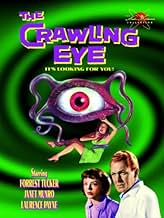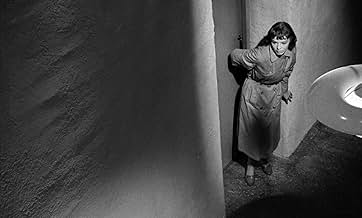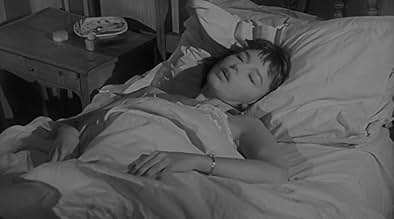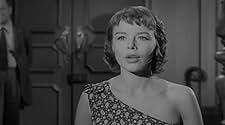VALUTAZIONE IMDb
5,2/10
5215
LA TUA VALUTAZIONE
Aggiungi una trama nella tua linguaA series of decapitations on a Swiss mountainside appear to be connected to a mysterious radioactive cloud.A series of decapitations on a Swiss mountainside appear to be connected to a mysterious radioactive cloud.A series of decapitations on a Swiss mountainside appear to be connected to a mysterious radioactive cloud.
- Regia
- Sceneggiatura
- Star
Recensioni in evidenza
When I was very young, I viewed Quentin Lawrence's "The Trollenberg Terror" and Irving Pichel's "The Most Dangerous Game" quite often on late night TV. In retrospect, they are very hokey, but at such an impressionable age, these two films scared my sister and me a great deal. In fact, I think they marked us for life.
"The Trollenberg Terror," more often referred to as "The Crawling Eye" -- I love that name -- is about two psychic sisters in a remote ski resort who are terrorized by a giant, tentacled eye which uses the fog to hide its movements. The film climaxes with a King Kong-like finale involving the United Nations and an aerial battle with phosphorous bombs.
What more could you ask for in a cinematic experience? :) ... Except perhaps some better special effects. :p
"The Trollenberg Terror," more often referred to as "The Crawling Eye" -- I love that name -- is about two psychic sisters in a remote ski resort who are terrorized by a giant, tentacled eye which uses the fog to hide its movements. The film climaxes with a King Kong-like finale involving the United Nations and an aerial battle with phosphorous bombs.
What more could you ask for in a cinematic experience? :) ... Except perhaps some better special effects. :p
A series of decapitations on a Swiss mountainside appear to be connected to a mysterious radioactive cloud, not unlike one that appeared in the Andes years earlier.
Although one of the earliest films to be lampooned on "Mystery Science Theater 3000", there is no denying the growing reputation this movie has received over the years: not only was it referenced in Stephen King's "It", but was also the primary influence behind John Carpenter's minimalist masterpiece "The Fog" (which itself has gone on to influence others).
"Crawling Eye" was the debut feature for director Quentin Lawrence, and probably remains his best-known work. Writer Jimmy Sangster (adapting the work of Peter Key) had only been working a few years, but was a rising star with such Hammer classics as "Dracula" and "Curse of Frankenstein" under his belt. Here he crafts a tale of science gone wrong mixed with the living dead, and done to perfection.
Most interestingly, shortly before the film was released, Lawrence directed a 6-part television miniseries with Key writing the episodes. Today, no copies are thought to exist, and there is no way to know what changes were made for the big screen, as well as what cuts had to be administered to accommodate the shorter running time.
Leading the cast is Forrest Tucker as United Nations troubleshooter Alan Brooks. Tucker had been in nearly 100 films during the 1940s and 50s, and easily handles his role here as the hero -- part action star, part scientific genius. He is assisted by Warren Mitchell as a caricatured Swiss professor (a portrayal which provides the film's only comic relief).
The standout performance comes from Janet Munro as a semi-psychic young woman who goes into trances when she nears the cloud. One gets the impression that she had a bright career before her, and indeed was given a Golden Globe in 1960. Sadly, she passed unexpectedly at age 38.
Today's audiences might find some of the special effects cheesy. Obviously the crew used miniature sets and plenty of rear projection. But in general, there is no denying the impressive use of fog, the freezing effects and the creepy realism of the titular eye. While other 1950s films were busy using radiation as a plot device for large bugs, this one went in a completely different direction -- possibly the only film of its kind.
Notably, "Crawling Eye" was the final film to be produced by Southall Studios, one of the earliest pioneer film studios in the UK, which had made a steady stream of films since 1924. They went out on a high note, which is always nice.
Although one of the earliest films to be lampooned on "Mystery Science Theater 3000", there is no denying the growing reputation this movie has received over the years: not only was it referenced in Stephen King's "It", but was also the primary influence behind John Carpenter's minimalist masterpiece "The Fog" (which itself has gone on to influence others).
"Crawling Eye" was the debut feature for director Quentin Lawrence, and probably remains his best-known work. Writer Jimmy Sangster (adapting the work of Peter Key) had only been working a few years, but was a rising star with such Hammer classics as "Dracula" and "Curse of Frankenstein" under his belt. Here he crafts a tale of science gone wrong mixed with the living dead, and done to perfection.
Most interestingly, shortly before the film was released, Lawrence directed a 6-part television miniseries with Key writing the episodes. Today, no copies are thought to exist, and there is no way to know what changes were made for the big screen, as well as what cuts had to be administered to accommodate the shorter running time.
Leading the cast is Forrest Tucker as United Nations troubleshooter Alan Brooks. Tucker had been in nearly 100 films during the 1940s and 50s, and easily handles his role here as the hero -- part action star, part scientific genius. He is assisted by Warren Mitchell as a caricatured Swiss professor (a portrayal which provides the film's only comic relief).
The standout performance comes from Janet Munro as a semi-psychic young woman who goes into trances when she nears the cloud. One gets the impression that she had a bright career before her, and indeed was given a Golden Globe in 1960. Sadly, she passed unexpectedly at age 38.
Today's audiences might find some of the special effects cheesy. Obviously the crew used miniature sets and plenty of rear projection. But in general, there is no denying the impressive use of fog, the freezing effects and the creepy realism of the titular eye. While other 1950s films were busy using radiation as a plot device for large bugs, this one went in a completely different direction -- possibly the only film of its kind.
Notably, "Crawling Eye" was the final film to be produced by Southall Studios, one of the earliest pioneer film studios in the UK, which had made a steady stream of films since 1924. They went out on a high note, which is always nice.
I kind of liked this movie for all of it's B movie glory. It's a great 50s sci-fi movie. It's a little boring but I thought the monster was pretty good. A great late night or after noon viewing, not even all that scary. Good solid drive in movie or the kind of movie that you would watch on TV late at night. I laughed at various points during the movie but they did a pretty good job with the monster. Even though, it's kind of boring, it's good to watch if you like schlock movies from the 50s like I do. I wish it had been a little more entertaining and scary. But I do have affection for the movies of this period. You can tell that they were trying to keep the cost down. The acting was okay, what you would expect to find in these types of movies. All around fun and excitement for a lazy afternoon.
Not every monster to come out of the fifties was a guy in a rubber suit or a double exposed giant something-or-other. This effective British thriller offers one of the most original monsters ever. The creatures are aliens looking to colonise our planet but first they have to lower the temperature and eliminate one small obstacle . . .us! The cyclopean, tentacled terrors are prone to tearing off the heads of their victims but they possess the technology to kill certain Earth people and bring them back from the dead to do their bidding. Interestingly, the creatures brain waves are easily intercepted by anyone with even latent psychic abilities. This makes Janet Munro our required damsel-in-distress from not only the monsters but from the man (Andrew Faulds) they reanimate to get rid of her. Luckily this movie has two heroes, rough hewn Forrest Tucker (to make the movie appealing to American audiences) and British Lawrence Payne (later to star in Hammer's VAMPIRE CIRCUS). Okay I have a question. Midway through the film we see 2 mountain climbers, Brett and Dewhurst, halfway up the mountain where the aliens are. They take shelter in a small cabin. During the night Brett hears the aliens telepathic call and wanders up the mountain alone. Later Dewhurst gets up to look for him and (I guess) sees one of the aliens coming toward the cabin. He quickly bolts the door but then turns around and screams. Later a search party has to break down the front door and they find Dewhurst dead with his head torn off. WHAT THE HECK GOT HIM? The cabin is intact, not even a window broken, so how in the world did the alien monster kill him? And how does Dewhurst's head get inside the knapsack of Brett who is miles away? No, it isn't Brett who kills him because he could not have gotten into the cabin either. It is indeed a scary moment but very implausible if you stop to think about it. The rest of the movie is very good and quite memorable. Way back in 1957 it played on a double bill with THE STRANGE WORLD OF PLANET X (a/k/a COSMIC MONSTERS) in America. That was a bit before my time and now I am kind of sorry I missed the era of the drive-in. Thank goodness for home video.
I saw this film, The Crawling Eye, on TV as a kid back in the very early 60s. Scared me to death. They keep the goodies from you until almost the end. Creepy. Kind of gross. I remember the mountain climbers at the very beginning of the flick: Why did you let go of the rope? Didn't you see him? His head was gone!! Don't miss this one- it's fun.
Lo sapevi?
- QuizJohn Carpenter has said that this film, with its creatures hidden in the clouds, was partly the inspiration for his film Fog (1980).
- BlooperAfter Brett gashes his forehead in a fight, they discover he does not bleed and that he is already dead. Yet Professor Crevette gives Brett an inject-able sedative in the arm. No blood means there is no way for the drug to travel to his brain.
- Citazioni
Sarah Pilgrim: *Was* there an accident, Mister Klein?
Mayor Klein: O-On a mountain, uh, dese things sometimes happen.
- Curiosità sui creditiThe film's opening credits flash onto the screen when the passenger train rolls into the darkness of a tunnel.
- ConnessioniEdited into FrightMare Theater: The Crawling Eye (2017)
I più visti
Accedi per valutare e creare un elenco di titoli salvati per ottenere consigli personalizzati
- How long is The Crawling Eye?Powered by Alexa
Dettagli
- Data di uscita
- Paese di origine
- Lingue
- Celebre anche come
- The Crawling Eye
- Luoghi delle riprese
- Alliance Film Studios, St Margarets, Twickenham, Middlesex, Inghilterra, Regno Unito(studio: made at Alliance Film Studios Ltd)
- Azienda produttrice
- Vedi altri crediti dell’azienda su IMDbPro
- Tempo di esecuzione1 ora 24 minuti
- Colore
- Proporzioni
- 1.66 : 1
Contribuisci a questa pagina
Suggerisci una modifica o aggiungi i contenuti mancanti

Divario superiore
What is the Spanish language plot outline for I mostri delle rocce atomiche (1958)?
Rispondi


























